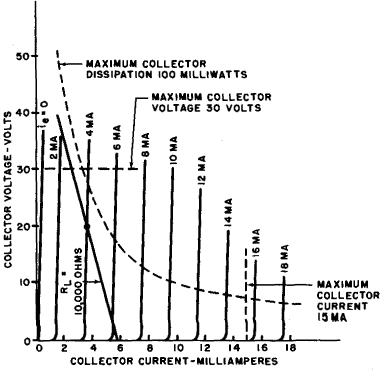| Transistor Basics is a free introductory textbook on transistors and their basic applications. See the editorial for more information.... |

|

Home  Grounded Emitter and Grounded Collector Transistors Grounded Emitter and Grounded Collector Transistors  Transistor Limitations Transistor Limitations  Maximum Limits Maximum Limits |
||






|
||
|
Maximum LimitsAuthor: Leonard Krugman
Fig. 4-16. Transistor collector IC-EC characteristic. Illustrating maximum limitation*. Figure 4-16 illustrates the three maximum limitations of a typical transistor having the following specified ratings: maximum collector dissipation -100 milliwatts; maximum collector voltage -30 volts; and maximum collector current -15 milliamperes. The useful region of the collector current-voltage characteristics is necessarily limited to the area contained within these boundaries. In circuit application, none of the limiting factors can be ignored; exceeding any of the limits may damage the transistor. For example, assume that the transistor illustrated in Fig. 4-16 is operated as follows: collector current Ic - 4 milliamperes, collector voltage Ec = 20 volts, load resistance RL = 10,000 ohms. Assume also that the a-c input signal causes a collector current variation of ±2 milliamperes. Thus, the output signal varies along the load line between the collector current limits of 2 to 6 milliamperes. The collector current never exceeds the maximum limit of 15 milliamperes, and at peak signal the collector dissipation is 40 volts times 2 milliamperes (80 milliwatts), which is well within the maximum power limits. However, the collector voltage is now 10 volts greater than the allowable limit of 30 volts. The transistor, therefore, would not be suitable for the assumed operation.
|
||
Home  Grounded Emitter and Grounded Collector Transistors Grounded Emitter and Grounded Collector Transistors  Transistor Limitations Transistor Limitations  Maximum Limits Maximum Limits |
||
Last Update: 2010-11-17


